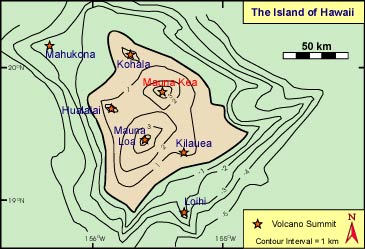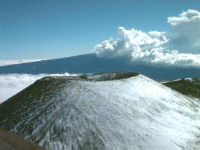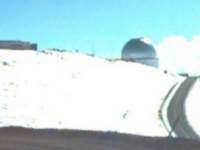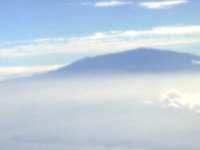Mauna Kea

Mauna Kea at sunrise looking north from Mauna Loa
![]()
|
Mauna Kea is the tallest mountain in the Hawaiian Chain. Its summit rises to an elevation of 4205m above sea level and it is located on the island of Hawaii. It is the second largest in subaerial surface area of the five shield volcanoes that comprise the island of Hawaii. |

|
Eruptive History
Mauna Kea is considered to be a dormant shield volcano in what is commonly known as the "post-shield" stage. Submarine eruptions began to build Mauna kea from the sea floor around ~0.8 million years ago. The basaltic shield stage of volcanism began by at least 0.3 million years ago. Alkalic postshield activity began about 60-70 thousand years ago and its youngest known eruptions occurred around 4000-5000 years ago. Mauna Kea's composition is primarinly tholeiitic basalt, capped by alkalic lavas of hawaiite to benmoreite compositions. Remnants of glacial terrane from the last global ice age (about 20,000 years ago) can be seen on Mauna Kea's summit.

Alkalic cinder cones at Mauna Kea's summit
Interesting Facts
 |
Mauna Kea is well-known to locals as, believe it or not, a great place
for skiing and snowboarding. Many people travel to the mountain every
winter because it often has snow at its summit and because there is a
road leading up to it. In fact, it is because of its sometimes snowy summit
that the Hawaiians named it Mauna Kea (or "White Mountain").
But be careful if you plan to visit. The air is thin up there and extremely gusty winds (upwards of 50-70 mph) can sometimes blow at the Mauna Kea summit. You can check the weather at the summit from the MK weather center |

|
Mauna Kea's summit is 9 kilometers above the adjacent ocean floor, making Mauna Kea mountain in the world. Because of its high altitude, thin and clean air, and great distance from urban areas, the summit of Mauna Kea is an idea place for sky watching and star gazing. In fact, this mountain is home to the world's most powerful telescopes and astronomical observatories, including the Keck telescope which has the world's largest mirror. Learn more at the UH Institute for Astronomy web site. |

|
Mauna Kea is sacred to the hawaiian people and the protection of sites or natural and cultural importance is under development. Read more at the Malama mauna Kea website. Like much of Hawaii, Mauna Kea is home to many rare and endangered plants, including the Wëkiu bug, the Palila (a rare bird), and the Mauna Kea Silversword. Learn more at the U.S. Fish and Wildlife Service web site. |
![]()

|

|

|

|
||
| HCV Home | Hawaiian Volcanoes | Loihi | Kilauea | Mauna Loa | Hualalai |
This page created by and maintained by Ken Rubin ©,
krubin@soest.hawaii.edu
Assisted by Brandon Doo, under the auspices of the Kailua High School
Community Quest work experience program
Other credits for this web site.
Volcano Quick Links
General Reference
Hawaiian volcano info:Links


